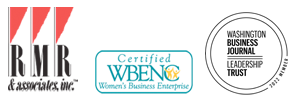Did you catch RMR’s recent column in Washington SmartCEO Magazine? If not, the article can be found below. You can also find all of RMR’s articles from the magazine here.
Does Your Brand Match Your Culture?
There has been a lot of talk recently about a company’s “brand.” As in: What’s your brand? And what if you want to change your brand? How do you go about doing that?
Before you can change your company’s brand or culture, you have to know what it is.
In order to change your company’s brand, you have to first understand what it is and how you got it.
Your company’s brand is its image, or how people perceive the company. A brand isn’t something you give yourself or your company. It isn’t necessarily what management wants it to be. It’s given to you by other people based on how they feel about you.
A CEO or marketing team can define what they want the company’s brand to be. They can try to affect it through marketing materials, ads, and tag lines. But, if people still don’t believe in or agree with what you say or put out there, it won’t become your brand.
A company’s brand can be influenced and shaped by many factors. Even the smallest things – the way your employees answer the phone and the way they dress – all can influence your brand.
For example, if your company’s printed materials and slogan announce that the company is “strong, firm, and fair,” but the receptionist answers the phone timidly or with a very soft voice, chances are others are not going to describe the company as strong or firm, so that part of your brand is not felt by the marketplace. Therefore, it’s not your brand. Or, if the company is being sued by different parties, it may not be perceived as “fair,” even if the lawsuits are baseless.
Once you understand what your company’s brand truly is, if it’s not what you want it to be, you can try to change it.
Your brand is embedded in your company’s culture.
Typically, the true brand can be found within the company’s culture. You have that brand for a reason: Your employees are living it and showing it to the world. So brand changes must start from within.
At RMR, we conduct a Positioning and Messaging Workshop with every new client. (We even held one for ourselves!) The purpose of the P&M is to get to the core brand that lives within the company, and which the employees project out into the world. If this core brand isn’t what the company wants it to be, change it by stating what you want it to be and defining steps that will accomplish it.
For example, teach the receptionist to project her voice loudly, and to smile before answering the phone. This gives her happiness and a positive outlook, which will be reflected in her voice.
Make sure employees know the company’s core ideologies.
Define what the company really believes in, and what it wants to tell or show the public. What are the company’s three to five key messages?
Then, ask yourselves if these messages are getting across. If your brand (how people perceive you) is different from your key messages, then your employees are not conveying these messages well.
What do your employees really believe about the company?
To change what they believe, you need to include the employees in the messages you send out to the public.
It’s so easy to do that, yet only 20% of companies include their employees in their outbound communications.
Here’s how to do that:
- Tell employees the company is changing or modifying its brand, from A to B.
- Include employees in every form of communication. If an email goes out to current customers, include employees too. (It’s easy to add a line saying, “This email has been sent to our current customers.”)
- Share the company’s successes with employees. People want to be proud of their company. Include numbers that show revenue increases or other improvements.
- Send employees hot-off-the-press copies, in advance if possible, of new brochures, press releases, and product sheets, etc. Point out any new language or ideas they should be telling their customers.
- Kick it off with a bang! Look for a natural time to start something new. Prepare everyone for the big change in the fourth quarter, and tell them it will kick off in the first quarter of the next year. Do a teaser, or send reminders, as the time approaches. Have a “Ta-da!” or “Wow!” factor when revealing the new language or ideas.
Make sure your employees are buying in to the new brand.
Change is hard for many people. Give employees some time to accept new ideas, but not too much time. Inevitably, there will be some who will not accept the changes. These “Negative Nellies” will drag the company down.
If they’re not going to get on board, they need to get off the boat. It’s tough to say good-bye to people, but sometimes it’s necessary. If people are still resistant after being given opportunities to adopt new ideas that will shape the new brand, it may be time to sever ties.
Sometimes it really is the best solution for everyone. They can move on and make a fresh start, and you can move forward to solidify your new brand, taking with you only those people who can and will make it happen.
